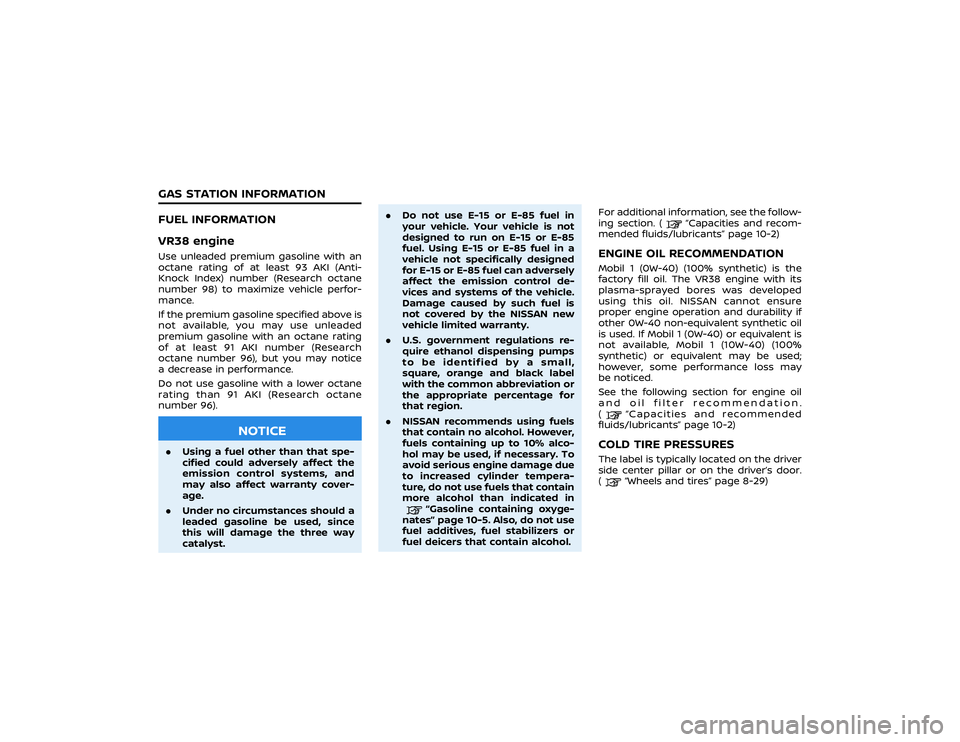NISSAN GT-R 2021 Owners Manual
GT-R 2021
NISSAN
NISSAN
https://www.carmanualsonline.info/img/5/56812/w960_56812-0.png
NISSAN GT-R 2021 Owners Manual
Trending: alarm, clock, key battery, steering wheel, air suspension, transmission oil, alternator belt
Page 441 of 1808
to detect
engine booming noise. The system then
automatically generates a noise cancel-
ling sound through the speakers
and
woofer
to reduce engine booming
noise.
The front and rear microphones
are
located inside of the roof.
The front speakers are located on the
doors and the woofer is located in
between the rear seats.
ACTIVE SOUND ENHANCEMENTThe active sound enhancement gener-
ates sounds according to engine speed
and driving modes selected by the Vehicle
Dynamic Control (VDC) system, transmis-
sion and suspension setup switches
through the speakers
and woofer
to enhance the quality of the engine
sound.
In addition, if the gear is shifted or the
accelerator pedal is quickly operated
when the transmission setup switch is in
R mode and the engine warmed up, a
sound effect is output to enhance the
sense of sportiness. (
“R mode” page
5-25)
Page 442 of 1808
Page 443 of 1808
WARNING
.If stopping for an emergency, be
sure to move the vehicle well off
the road.
. Do not use the hazard warning
flashers while moving on the
highway unless unusual circum-
stances force you to drive so
slowly that your vehicle might
become a hazard to other traffic.
. Turn signals do not work when
the hazard warning flasher lights
are on. In the event of a roadside emergency,
Roadside Assistance Service is available
to you. Please refer to your Warranty
Information Booklet (U.S.) or Warranty &
Roadside Assistance Information Booklet
(Canada) for details.
HAZARD WARNING FLASHER SWITCH
ROADSIDE ASSISTANCE PROGRAM
Page 444 of 1808
Page 445 of 1808

could affect the proper operation
of the TPMS.
. Do not inject any tire liquid or
aerosol tire sealant into the tires,
as this may cause a malfunction
of the tire pressure sensors.
NOTE:
. You can check the pressure of all
four tires on the touch screen dis-
play. See the separate Multi Func-
tion Display Owner’s Manual.
. The tires of this vehicle are filled
with nitrogen gas. When the tire
pressure is low, fill the tires with
nitrogen. It is recommended you
contact a GT-R certified NISSAN
dealer for information on filling the
tires with nitrogen.
. If nitrogen is not available, com-
pressed air may be safely used
under normal driving conditions.
However, NISSAN recommends re-
filling with nitrogen for maximum
tire performance.
RUN-FLAT TIRESRun-flat tires are those tires that can be
used temporarily if they are punctured.
(
“Run-flat tires” page 8-36)
Also, see the tire safety information in the
Warranty Information Booklet.
position.
4. Turn off the engine.
5. Raise the hood to warn other traffic,
Page 446 of 1808
Page 447 of 1808
and remove rings, metal bands,
or any other jewelry. Do not lean
over the battery when jump start-
ing.
. Do not attempt to jump start a
frozen battery. It could explode
and cause serious injury.
. Your vehicle has an automatic
engine cooling fan. It could come
on at any time. Keep hands and
other objects away from it.
Page 448 of 1808
, position the two vehicles (
and
) to bring their batteries into
close proximity to each other. Do not
allow the two vehicles to touch.
2. Apply parking brake. Move the shift lever to the
position. Switch off all unnecessary electrical systems (light,
heater, air conditioner, etc.).
3. Remove the battery cover. Cover the battery with a firmly wrung out moist
cloth to reduce explosion hazard.
4. Connect jumper cables in the se- quence as illustrated (
?
?
CAUTION
.Always connect positive (+) to
positive (+) and negative (−) to
body ground (as illustrated), not
to the battery.
. Make sure that the jumper cables
do not touch moving parts in the
engine compartment and that
clamps do not contact any other
metal.
5. Start the engine of the booster vehicle
and let it run for a few minutes.
6. Keep the engine speed of the booster
In case of emergency
6-7
Page 449 of 1808

.
NOTE:
Do not keep the starter motor en-
gaged for more than 10 seconds. If
the engine does not start right away,
push the ignition switch to the OFF
position and wait 10 seconds before
trying again.
7. After starting your engine, carefully disconnect the negative cable and
then the positive cable (
?
?“Removing the cowl top cover”
page 8-5) Do not attempt to start the engine by
pushing.
NOTICE
Your NISSAN cannot be push-started
or tow-started. Attempting to do so
may cause transmission damage.
WARNING
.
Do not continue to drive if your
vehicle overheats. Doing so could
cause engine damage or a vehicle
fire.
. To avoid the danger of being
scalded, never remove the radia-
tor filler cap and the coolant
reservoir cap while the engine is
still hot. When the cap is removed,
pressurized hot water will spurt
out, possibly causing serious in-
jury.
. Do not open the hood if steam is
coming out.
If your vehicle is overheating (indicated by
an extremely high temperature gauge
reading), or if you feel a lack of engine
power, detect unusual noise, etc., take the
following steps:
1. Move the vehicle safely off the road, apply the parking brake and move the
shift lever to the
position.
Do not stop the engine.
2. Turn off the air conditioner. Open all the windows, move the temperature
control to maximum hot and fan
PUSH STARTING IF YOUR VEHICLE OVERHEATS
Page 450 of 1808
Trending: brake pads replacement, fuel pump, width, differential, ground clearance, low beam, oil type









